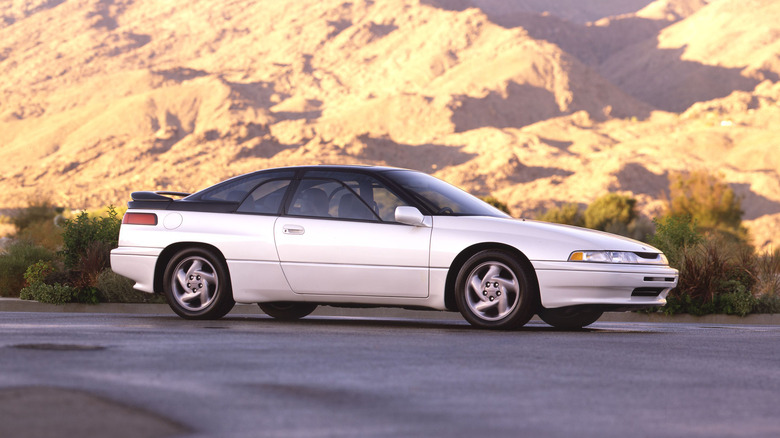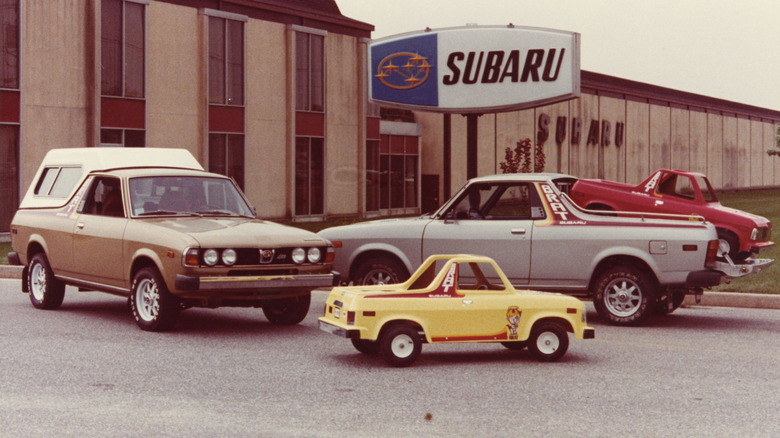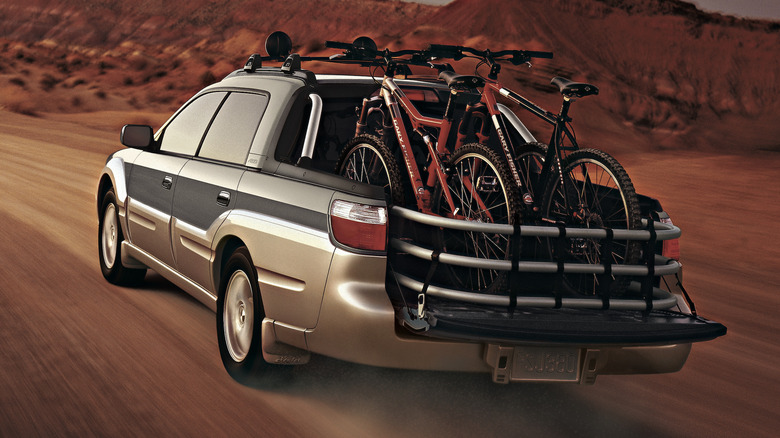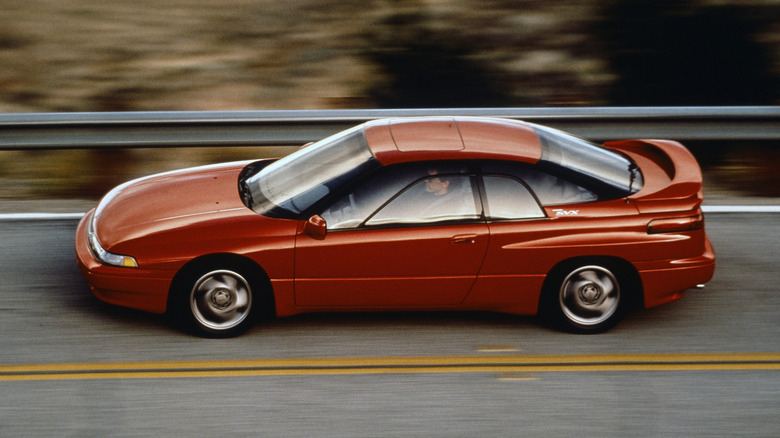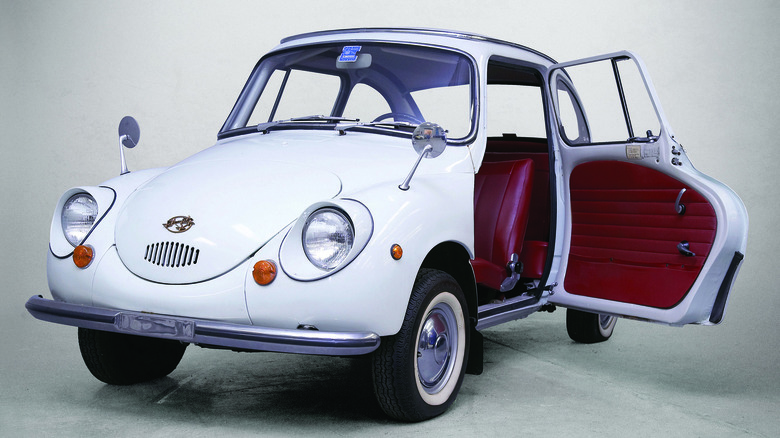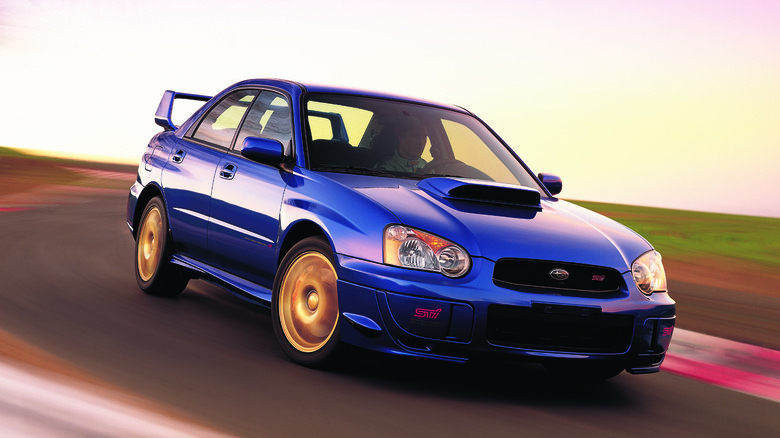5 Discontinued Subaru Models That Deserve A Second Chance
Subaru has been selling cars in America for over 50 years, and, in that time, it's built a reputation for reliability, off-road capability, and rugged vehicles in many different shapes and sizes. High-performance rally cars are a relative constant for Subaru over the years, with a number of iconic racecars throughout its history as well. Over the last five decades, Subaru has come out with some icons on the dirt as well as historically-significant road-going vehicles. And some of those road-going icons are still in production, but many have been discontinued.
Subaru is like most other automakers in the sense that many of its models have come and gone over the years. Even if a model is popular, shifting industry regulations or brand direction could relegate a vehicle to the scrap heap. But not all of the deceased Subaru models deserve to stay dead. There are several discontinued Subaru models that have name recognition, unique design features, and cult followings that could support a comeback. Out of all the Subarus that have come and gone, these five deserve a second chance.
Subaru Brat
There are few vehicles as quirky or as iconic in their strangeness as the Subaru Brat. The Brat was available in the United States for less than a decade, lasting from just 1978 until 1987, but over the years it has gained cult-classic levels of enthusiasm, with surprisingly high market values. BRAT is technically an acronym for Bi-Drive Recreational All-Terrain Transporter (with the Bi-Drive referring to all-wheel drive), alluding to the Brat's built-in off-road capability. A small and inexpensive pickup, the Brat was rated by the EPA with fuel economy estimates as high as 28 mpg highway in the 1980s. It had curb appeal, but it was more than just an attractive truck — it was built to get around America's Chicken Tax.
The Chicken Tax was (and still is) a 25 percent tax on imported light trucks – i.e. the Brat. So, Subaru put a couple of rear-facing seats in the bed of the Brat and classified as a passenger vehicle instead of a truck, reducing the import tax to a comparatively miniscule 2.5 percent. Theoretically, passengers would sit in the bed of a pickup truck with no protection from the elements, but many owners removed the seats, giving the Brat maximum utility as a pickup. A new Brat, if it were small and efficient (potentially even powered by electricity) could be just as popular as the Ford Maverick – and you wouldn't need-rear facing seats.
Subaru Baja
The Baja is a lot like the Brat in the sense that it offered truck-like utility on a car platform. The Baja was built on the same platform as Subaru's wagon, the Outback, but instead of a closed-in wagon, it was built as a pickup truck or ute. Unlike the Brat, however, the Baja came with four doors and all of its seats were inside the cabin. The Baja lived an even shorter life than the Brat, only being offered from 2003 to 2006. Poor sales led to Subaru's early discontinuation of the Baja, but some believe that the Baja was just ahead of its time, and giving it another go today would be more successful.
The success of modern compact trucks like the Maverick, and to a lesser degree the Hyundai Santa Cruz, prove that there's a relatively large market for pint-sized utility. Bringing back the Baja today could follow a similar formula to the original – using an existing platform and adding a bed – but it might make more sense to do it on something smaller. The Subaru Crosstrek, for example, is compact and rugged, and more efficient than larger Subarus like the Outback. And if you're on board with bringing back the Baja, there's already enthusiast-inspired merch ready to help launch a grassroots movement.
Subaru SVX
The SVX was Subaru's attempt at a luxury sport coupe, with a 2+2 seat configuration and powered by a flat-six boxer engine that put out 230 horsepower and 228 lb-ft of torque. That might not seem like a lot since it's about the same amount of horsepower as today's Subaru BRZ, their current two-door sport coupe, but it was relatively impressive for its day. The SVX was produced from 1992 to 1997 and it was available with either front- or all-wheel drive, another distinction it has when compared to the rear-drive-only BRZ.
Most of the vehicles in Subaru's lineup today have four doors and room for families of various shapes and sizes. In fact, only one Subaru (the BRZ) is currently available with two doors. Adding the SVX back into the lineup would certainly add a bit of diversity to the lineup and give Subaru designers the chance to test out all sorts of quirky design ideas like the SVX's window-within-a-window setup that was designed to keep out wind noise at speed. The 3.3-liter engine under the hood of the SVX was powerful enough for its day, but not particularly exciting, so using a new flat-six engine wouldn't be a requirement for a new model – they'd just need to make it quick. Maybe even a turbocharged version of the current 2.4-liter, 228-horsepower engine that powers the BRZ could get the job done.
Subaru 360
The Subaru 360 was America's introduction to Subaru. It was first produced in 1958 but it wasn't imported into the United States until 1968. The 360 was aptly named, as it used a 360cc engine that produced between 16 and 36 horsepower, depending on the trim level. It was available as a two-door coupe, a van, or as a pickup truck. (Bet you didn't expect a third Subaru pickup truck on the list, did you?!)
In a strangely honest ad campaign, the 360 was marketed as "Cheap and Ugly" with a starting price of $1,297 – $300 less than the Volkswagen Beetle at the time, and weighing 1,000 pounds less. Put that price into an inflation calculator that compares 1968 dollars to 2024 dollars and you'd get a starting price for the 360 of around $12,000 – over $35,000 less than the average price of a new car today. The 360 also offered incredibly high fuel economy numbers, boasting up to 66 miles per gallon. A modern Subaru 360 would likely compete with other tiny, city-friendly vehicles like the Fiat 500e.
WRX STI
The WRX STI is one of the most iconic nameplates that Subaru has ever produced. WRX stands for World Rally Experimental, and STI, of course, is short for Subaru Tecnica International, Subaru's in-house tuning company that pumps up the performance on certain specific models. The WRX is Subaru's four-door compact sedan (and sometimes wagon) that was launched in 1992 and went on to win a number of rally championships, paving a path to its iconic status along the way. And while the WRX is still being produced, there's no STI model to be found.
Sure, the current WRX is quick, but with just 271 horsepower, it's not quite powerful enough to compete with hot hatches like the Toyota Corolla GR (300 hp) or the Honda Civic Type R (315 hp). Subaru offers the WRX in a TR trim currently, which adds performance upgrades like Brembo brakes, upgraded suspension and Recaro seats, but an STI version of the WRX would likely close the horsepower gap and make the competition in the high-performance compact-car segment just a little bit hotter.
